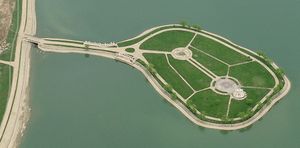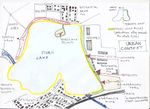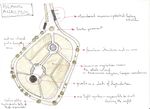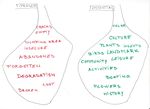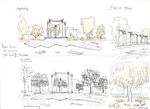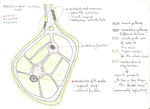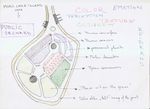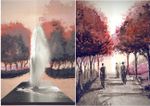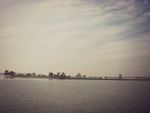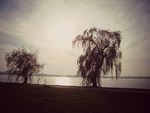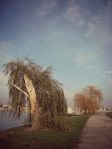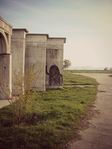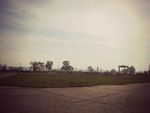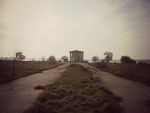Planting Design 2013 Working Group 1 - Case Study A
---> back to group page working group 1
Morii Lake Island - The forgotten island of Bucharest
Rationale: Why is this case interesting?
Morii Lake is the largest lake in Bucharest, man-made in 1986 to protect the city from floods. During the construction, on the north part of the lake an artificial island was created known as "Morii Lake Island". With an area of 4.2 ha the island was designed by combining a natural design within a formal framework. The goal was to achieve a romantic image so plants were chosen for their color, flowering or for what they symbolized, like for example groups of willows along the lake side. The landscape created, even though it had an artificial basis was perceived as a highly natural one.
There are two major aspects that make this case an interesting one. The first one focuses on the island's history, which is divided in two main periods: 1986-1989 and 1989-present day. During 1986-1989 the island was a highly valued area in Bucharest, where a lot of cultural outdoor events took place attended even by Ceausesc, picnics or boat rides. After the revolution in 1989 the area suffered from a lack of maintenance and it is in a constant state of degradation, being now no more than a place to dump garbage. The second aspect I consider relevant is the fact that "Morii Lake Island" is known to be the only island in Bucharest, so this unique characteristic gives the area a really high potential.
Author's perspective
As an urban and landscape planner I am documenting this case focusing on the revival of a neglected landscape that holds a lot of potential. The matter of neglected landscapes is a problem I have seen occurring nowadays due to the rapid urban development, or better say the "modern times". People are in a constant search for the "new" factor (new areas, new facilities, new images) and this leads to an indifference towards the "everyday" elements including landscape and nature. It has been proven in a study that people never look to see more then what is in their visual range, so how can you make them look? We are so fixated on our routes that even the most beautiful landscape gets lost in the background.
I consider that one of the keys in solving this problem is social activism by getting people involved in projects such as urban and landscape regeneration, making them aware of what it is around and letting them come up with solutions. By implicating local people in the decision-making process, it allows unique approaches in regenerating neglected areas and landscapes through aesthetic, cognitive and emotional dimensions. The sites character and past together with the interpretation of objects and symbols sit at the basis of a cultural landscape as a way of variety.
There are three principles I believe to be relevant for a case study: valuing the existent, defining what is missing and developing the potential. This focuses on identifying the strengths and weaknesses of the site, along with the opportunities and threats that come from the outside environment. Basically it refers to an inside-out approach that covers all the factors of the case study.
Landscape and/or urban context of your case
- Urban context - History/Dynamics
The urban space goes through continue changes, reshaping it’s identity with each time frame and trends in the planning of cities, which also implies a reconfiguration of the city landscape, the two being undeniably connected. During the communist period, one of the biggest projects was the construction of Morii Lake, and artificial lake within the urban area of Bucharest that modified the natural and anthropogenic environments. The project had a huge impact on the area’s landscape due to demolitions and displacements of buildings and agricultural terrains left with no use, cutting down crop layers, meadows, rows of trees, isolated tress and shrubs. These actions lead to the loss of specific elements that characterize the periphery landscape.
Morii Lake is the largest lake of Bucharest occupying an area of 220 ha, built at the entrance of the Dambovita River in the city. The lake was built between 1985 – 1987, with the purpose of protecting the city from floods and for rational water management. It is surrounded by longitudinal dykes and in 1986 an island was built on the north part, know as Morii Lake Island. Being built on such a short term, the project involved major actions like neighborhood demolition, monuments have been destroyed and people have been relocated, creating a disruption in the urban space. This disruption was not solved, no urban development plans were made and the Morii Lake area was completely neglected by the authorities, leaving the environmental disfunctionalities to amplify.
Regarding the effects of the lake on the landscape there can be mentioned positive and negative ones. The positive effects identified are: reducing of flood risks, new favorable ecosystem, recreation and nautical sports, fishing activities, renewable non-polluting energy and a new nature area for the city that encourages tourism. As negative effects there can be mentioned: changing the downstream biotope and the downstream ecosystem, biotic instability, local climate change and reduce local natural elements.
Twenty six years later, there continues to be a discontinuity in the urban fabric and landscape. The area is like a puzzle composed of improvised establishments by Romani people, new residential assemblies, industrial and commercial units, abandoned arable land and green areas used as dumping places in the close proximity of the lake.
- Island analysis - Overall charcter through time
Built in 1986 on an area of 4.2 ha, the Morii Lake Island was designed as a place of nature for the community. The design consisted of a high percentage of vegetation, with a “green belt” of Salix alba around the island’s limits and a “green core” of various Rosa species. One of the major goals in creating this area was to have diverse activities in a natural environment and for this were built two marinas, a gazebo and a flower-shaped fountain.
1986 – 1990
During the communist period there were a lot of cultural events taking place on the island due to the natural surroundings. The main function was that of a recreational area, with boat and water-sport contests, fishing contest, festivals and concerts. It was considered as a family environment (picnics, improvised playgrounds, fishing) and a key area for tourism activities because it is the only island of the capital. The popularity of the area grew so much that even the president Ceausescu attended several events that took place there.
1990 – present
At the beginning of 1990, after the revolution, the dynamics started to change and the authorities decided to cut off the funds for the island’s maintenance. This decision led the area to fall in a constant state of degradation and it ended up to be abandoned and neglected by the whole community. In present day, a quick analysis of the island shows several major problems regarding functional, natural and aesthetic elements: abandoned marina, gazebo in a state of degradation, broken pavement, no light system, sanitary waste, invasive vegetation. The area is considered highly insecure and the only activity remaining is that of occasional fishing.
- Map Images
Analytical drawings
- Key words: chaotic development, history, landmark, abandoned, insecure, degradation, broken, perception
- Analytical Drawings
Projective drawings
- How would you like this case to change in the near future? (in 1-2 years)
For this short period of time my approach is based on there steps: safe, clean and green. Because the island is located in a suburb part of the city that is considered not safe due to illicit activities, creating a light system for the whole island will improve the image it has at night. This will help it be more secure and also accessible once the sun sets. The next steps, making it green and clean are two methods based on a more social level, by trying to make the people aware of the problems and involved in redeveloping the island, maybe with a motto like "A tree a day keeps the doctor away". This way, a replanting project can have a more personal approach, to which people can relate.
- And how could it look like in 10-15 years?
Redeveloping the Morii Lake Island as a public orchard offers a new perspective of the area's residents and beneficiaries of the recreation potential. Re-branding the island into an orchard may seem unrelated to the area, but it focuses on people's emotions like how it feels to see fruits growing in the tree you planted. This development along with new green spaces for picnics, sports, bike lanes will change the aesthetic, cognitive and emotional perceptions of the landscape and it will revive the island.
- Projective Drawings
Summary and conclusion
Morii Lake Island is an example of the negative effects people have on the environment and how unaware they can be about it. The goal was to recreate nature within the city, only to forget about it let it disappear. My proposal aims to reshape the island through social based projects because people need to be aware of what is around them and even taught about the implications their actions have on the image of the city and the environment.
Image Gallery
How does it make you feel?
- Image Gallery
References
* Web links: http://uac.incd.ro/Art/v4n4a04.pdf * http://www.b365.ro/insula-ascunsa-a-bucurestiului_42975.html
* Maps: Google Maps application
About categories: You can add more categories with this tag: "", add your categories
